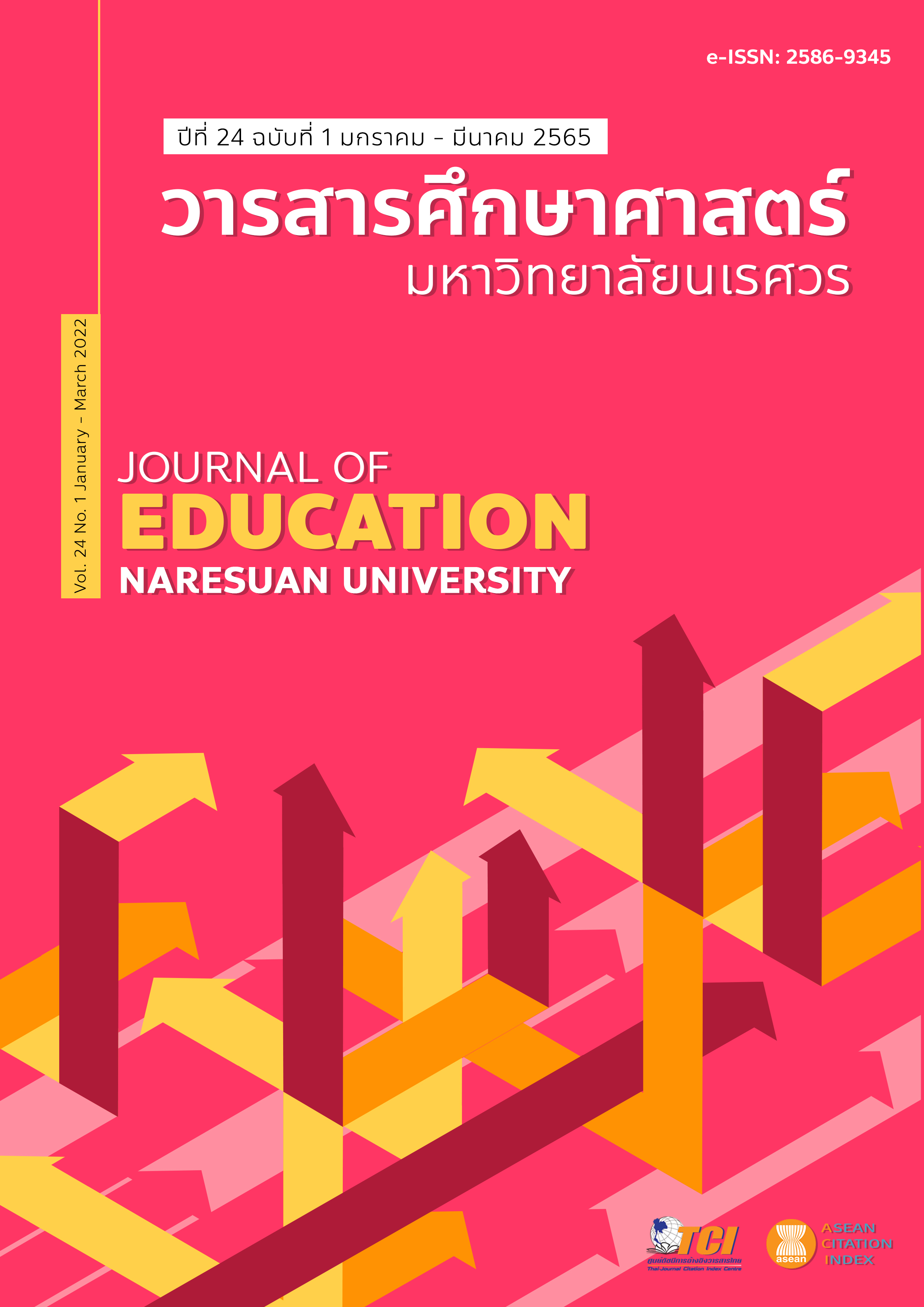การจัดการเรียนรู้ตามแนวสะเต็มศึกษาที่เน้นกระบวนการออกแบบเชิงวิศวกรรมเพื่อส่งเสริมสมรรถนะการแก้ปัญหาแบบร่วมมือ เรื่อง การเคลื่อนที่แบบต่างๆ ของนักเรียนชั้นมัธยมศึกษาปีที่ 4 STEM EDUCATION BASED ON ENGINEERING DESIGN PROCESS FOR DEVELOPING GRADE 10 STUDENTS’ COLLABORATIVE PROBLEM SOLVING COMPETENCIES IN MOTIONS TOPIC
Main Article Content
บทคัดย่อ
การวิจัยครั้งนี้ มีวัตถุประสงค์เพื่อศึกษาแนวทางการจัดการเรียนรู้ตามแนวสะเต็มศึกษาที่เน้นกระบวนการออกแบบเชิงวิศวกรรม และพัฒนาสมรรถนะการแก้ปัญหาแบบร่วมมือของนักเรียนชั้นมัธยมศึกษาปีที่ 4 เรื่อง การเคลื่อนที่แบบต่างๆ กลุ่มเป้าหมาย คือ นักเรียนชั้นมัธยมศึกษาปีที่ 4 จำนวน 45 คน เครื่องมือที่ใช้ในการวิจัย ได้แก แผนการจัดการเรียนรู้ แบบสังเกตสมรรถนะการแก้ปัญหาแบบร่วมมือ แบบทดสอบสมรรถนะการแก้ปัญหาแบบร่วมมือ และแบบสังเกตการจัดการเรียนรู้ ผู้วิจัยนำข้อมูลมาวิเคราะห์เชิงเนื้อหาและใช้วิธีการตรวจสอบข้อมูลแบบสามเส้า ผลการวิจัย พบว่า แนวทางการจัดการเรียนรู้ที่ส่งเสริมสมรรถนะการแก้ปัญหาแบบร่วมมือ คือ 1) กำหนดสถานการณ์ที่ทันสมัยและเกี่ยวข้องกับชีวิตประจำวัน 2) กำหนดภาระงานที่ท้าทายในชั้นเรียน ได้แก่ การทดลอง การสร้างชิ้นงาน และการทดสอบ 3) กระตุ้นให้นักเรียนสะท้อนความคิดและมีการประเมินความเข้าใจร่วมกันผ่านการแลกเปลี่ยนความคิดเห็น และผลการพัฒนาสมรรถนะการแก้ปัญหาแบบร่วมมือของนักเรียนส่วนใหญ่มีระดับความสามารถระดับสูงและปานกลาง เมื่อพิจารณาสมรรถนะที่พัฒนาดีที่สุด คือ สมรรถนะการสร้างและรักษาระเบียบของกลุ่ม รองลงมา คือ สมรรถนะการสร้างและเก็บรักษาความเข้าใจที่มีร่วมกัน และลำดับสุดท้าย คือ สมรรถนะการเลือกวิธีดำเนินการที่เหมาะสมในการแก้ปัญหา
Article Details

This work is licensed under a Creative Commons Attribution-NonCommercial-NoDerivatives 4.0 International License.
เจ้าของบทความมิได้คัดลอก หรือละเมิดลิขสิทธิ์ของผู้ใด หากเกิดการละเมิดลิขสิทธิ์ ไม่ว่าวิธีใด หรือการฟ้องร้องไม่ว่ากรณีใด ๆ ที่อาจเกิดขึ้นได้ กองบรรณาธิการวารสารศึกษาศาสตร์ ไม่มีส่วนเกี่ยวข้องทั้งสิ้น ให้เป็นสิทธิ์ของเจ้าของบทความที่จะดำเนินการ
References
Antonenko, P. D., Jahanzad, F., & Greenwood, C. (2014). Fostering collaborative problem solving and 21st century skills using the DEEPER scaffolding framework. Journal of College Science, 43(6), 78-87.
Asghar, M. Y., Viitanen, T., Kemppainen, K., & Tornquist, K. (2012). Sphingosine 1- phosphate and human ether-a'-go-go-related gene potassium channels modulate migration in human anaplastic thyroid cancer cells. Endocrine - Related Cancer, 19(5), 667-680. https://doi.org/10.1530/ERC-12-0092
Bitter, C. G. (1990). Mathematics method for the elementary and middle school: A comprehensive approach. Boston: Allyn and Bacon.
Bureau of Academic Affairs and Educational Standards [BAAES]. (2015). Collaborative problem solving. Retrieved January 25, 2020, from https://drive.google.com/folderview?id=0BwnYgcDtSNqaQkU3VzVEdXdqNG8&usp=sharing&tid=0BwnYgcDtSNqaTTIwS1ZhdHVXMzg. [in Thai]
Householder, D. L., & Hailey, C. E. (2012). Incorporating engineering design challenges into STEM courses. Retrieved November 10, 2019, from https://digitalcommons.usu.edu/ncete_publications/166
Institute for the Promotion of Teaching Science and Technology (IPST). (2014). Activity Manual for Level4 (M.4-M.6), Bangkok: Institute for the Promotion of Teaching Science and Technology (IPST), Ministry of Education. [in Thai]
Institute for the Promotion of Teaching Science and Technology (IPST). (2018). PISA 2015 Assessment of Reading Science and Mathematics Excellence and educational equality. Bangkok: Success Public Company Limited. [in Thai]
Joyce, B., & Weil, M. (1996). Model of teaching (5th ed.). Boston: Allyn and Bacon.
Kemmis, S., McTaggart, R., & Nixon, R. (2014). The action research planner: Doing critical participatory action research. New York: Springer.
McNaught, C. (2014). Implementing research based education at UCL. Retrieved May 2, 2020, from http://www.ucl.ac.uk/teaching-learning/connectedcurriculum/research-based-education
Organization for Economic Co-operation and Development (OECD). (2015). PISA 2015 draft collaborative problem solving framework. Paris: OECD.
Nualpong, W. (2010). Development of learning activity management based on CIPPA model in the invention of Thai wisdom topic of artificial intelligence subject for grade 12 students (Independent Study). Mahasarakham: Mahasarakham University. [in Thai]
Susan, H., & Marci, D. (2011). NASA’s best students beginning engineering science, and technology. Retrieved August 1, 2019, from https://www.nasa.gov/audience/foreducators/best/edp.html
Suthee, S., Wanpakae, P., & Saengtopho, S. (2001). Techniques for developing an integrated curriculum. Bangkok: Development Education. [in Thai]
The Secretariat of the Council of Education. (2018). Thai Education Report 2018 (Education in Thailand 2018). Bangkok: The Secretariat of the Education Council Ministry of Education. [in Thai]

